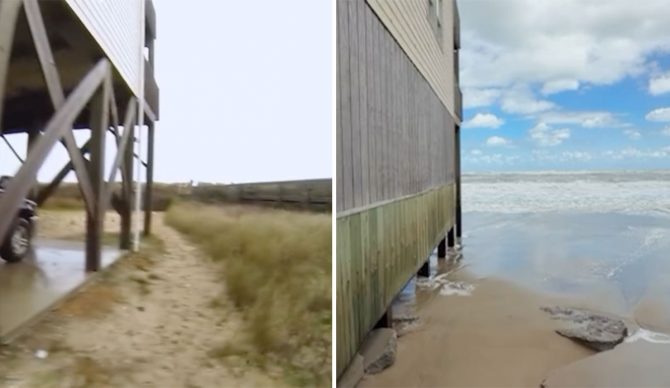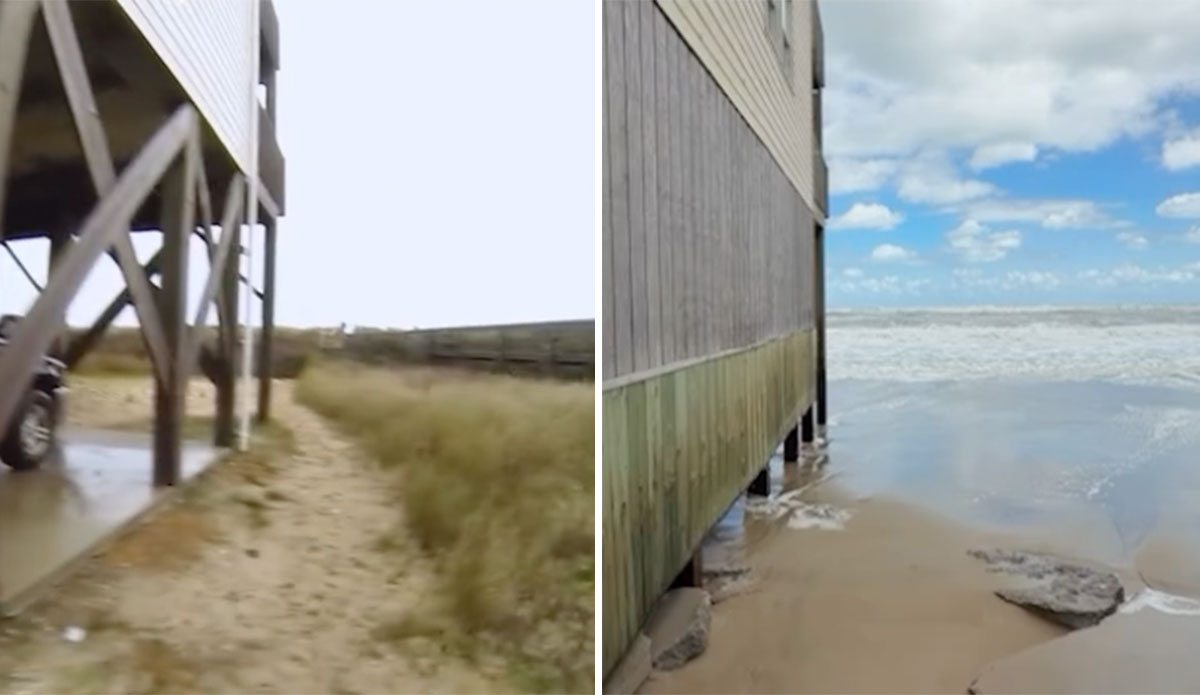
Same place, ten years of coastal erosion. It’s a lot, right? Photos: Brett Barley//Instagram
![]()
The Bible recommends that you do not build your house on the sand. It says that you’re a fool if you do, because if you haven’t built on the rock, when the rain falls and the floods come and the winds blow and beat against that house, that house will fall. “Great will be the fall of it,” the Book says. But what does one do when the house didn’t appear to be on the sand when you built it? North Carolina is one of the most obvious places in the United States where coastal erosion is occurring, and a recent video comparison from Brett Barley shows the frightening extent of it.
“What does 10 years of severe coastal erosion look like?” Barley asked in an Instagram post. “Let these two near-identical video angles, from the exact same location, show you the difference in a beach in Buxton, North Carolina from 2014-2025. I shot the first one with my GoPro going surfing in 2014 and recreated it with my iPhone two days ago post-Hurricane Erin.”
In the last five years, 13 homes on the Outer Banks have fallen into the ocean. As weather events become stronger and more frequent, beautiful places that sit on the edge of the sea are becoming precarious places to live. Hurricane Erin was just the most recent example of what a storm — even one that doesn’t make landfall — can do when it comes to beach erosion. Many homes are now literally teetering on the edge, with the ocean creeping closer and closer to their front doors with each passing year. According to Barley, a lot has changed in the last decade.
“The jetty at the old Cape Hatteras Lighthouse site began rapid deterioration in 2015,” he remembered. “With more and more holes forming in the groin, and sections falling in 2021-2025, we are now here present day because it no longer holds sand like it use to, even with over half the jetty still there. Rebuilding that groin is crucial to the support of Buxton, NC.”
Even with a rebuild, though, it feels like a losing battle. The seas are rising and they’re rising faster and faster each year. No number of heads in the sand will stop it.
“The rate of global sea level rise is accelerating,” researchers at NOAA wrote. “It has more than doubled from 0.06 inches (1.4 millimeters) per year throughout most of the twentieth century to 0.14 inches (3.6 millimeters) per year from 2006–2015.”
Throughout the world, there are many places that are facing a slow-moving disaster in the coming decades. The U.S. is not immune.
“In many locations along the U.S. coastline, the rate of local sea level rise is greater than the global average due to land processes like erosion, oil and groundwater pumping, and subsidence,” NOAA wrote. “High-tide flooding is now 300 percent, to more than 900 percent more frequent than it was 50 years ago.”
In a frustrating, yet all-too-common refrain when it comes to environmental issues, we know what we need to do — we’re just not doing it.
“If we are able to significantly reduce greenhouse gas emissions, U.S. sea level in 2100 is projected to be around 0.6 meters (2 feet) higher on average than it was in 2000,” NOAA explained. “On a pathway with high greenhouse gas emissions and rapid ice sheet collapse, models project that average sea level rise for the contiguous United States could be 2.2 meters (7.2 feet) by 2100 and 3.9 meters (13 feet) by 2150.”
